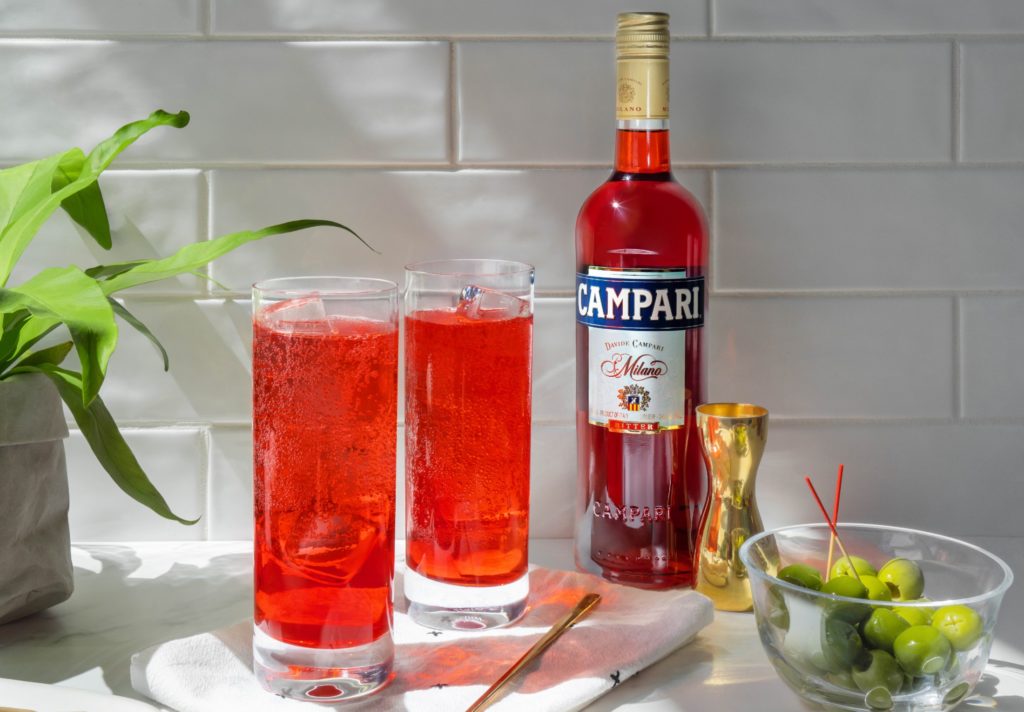When you look at a bottle of Campari, the first thing you probably notice is its bright, blood-red hue. At first glance, you might think that this liqueur is sweet, but it’s actually super bitter.
Its palate is filled with herbal notes, which can also be noticed in its aroma. It also contains a hint of orange. This drink is made from a proprietary blend of herbs and spices.
Campari is also an ingredient in several classic cocktails like the Negroni, the Old Pal, and the Americano. Campari is an excellent ingredient in mixed drinks despite its bitter taste, providing great depth and nuance. In fact, many people love it specifically for its bitterness.
This Italian liqueur has been enjoyed since the mid-19th century and is considered an aperitif. It’s stood the test of time and continues to be a favorite among bitter spirit lovers. When it comes to bitter liqueurs, there isn’t a name as reputable as Campari.
A unique origin story
The story of the Campari brand starts in the early 1860s, with a former bartender named Gaspare Campari. He made a name for himself as a cafe proprietor, inventing multiple bottled cocktails in the cellar of his establishment in Milan.
His strategy was to mix neutral alcohol with sweeteners like raspberry juice, vanilla, and cocoa. Campari would practically use anything he could get his hands on.
One day, he came up with a blend of equal parts of alcohol, sugar syrup, distilled water, and an infusion of oranges, rhubarb, and ginseng. He also included a secret mixture of herbs, which is still classified to this day.
Apparently, the secrecy of the herbal blend is so serious that ingredients for Campari are shipped straight to the director’s office in plain, brown packaging. The director is the only one who knows the full recipe.
How is Campari made?
The recipe for this drink hasn’t changed since its inception. Though we don’t know exactly how it’s made, we do know the general production process.
For one, the dry ingredients of Campari are soaked in water for two whole days. Then, they’re combined with more alcohol and water. Finally, the mixture is steeped in large vats for 15 days.
After this process, the brew should hold a dark brown color and taste very bitter, too bitter to drink. The liquid is drained into blending tanks to mitigate this issue, where the macerated dregs are pressed for their juice. The soggy leftovers are then boiled, allowing for more alcohol to be distilled.
As a final step, sweetening syrup and coloring are added. Despite the brilliant red color, Campari no longer uses cochineal dye, a popular colorant produced from dried cochineal insect bodies—meaning that this liqueur is safe for vegans to consume.
Before being bottled, the alcohol content of the drink must be adjusted. Batches of Campari are bottled at 57 proof or 28.5% ABV for European markets. They’re bottled at 48 proof or 24% ABV for the American market.
Campari bottles sold in America also feature a different label than the European version. The U.S. bottle has the word “Aperitivo” printed on it, which is Italian for “aperitif.” The European bottles don’t have this label. Aperitivo Campari is considered the bitter version of the drink.
The success of Campari
During the 1990s, the Campari brand reached the pinnacle of its success. In 1994, Sesto San Giovanni, a commune in Milan, produced 16 million liters of Aperitivo Campari. That’s equivalent to 21 million bottles of the drink.
Out of these 16 million liters, 11 million were exported. Four million of these liters were sent to Germany, the largest market by far for bitter Campari.
Though Germany dominates in that category, the motherland of Italy is still the number one overall Campari-drinking nation. Unlike Germany, the citizens of Italy really appreciate the different renditions of the drink, like Campari Soda.
It’s also interesting to note that at Sesto San Giovanni, only one other product is made besides bitter Campari: Cordial Campari.
This is a rendition of Campari that’s distilled from raspberries. Unlike traditional Campari, which is red in color, Cordial Campari is nearly transparent. In the 1950s and 1960s, this drink was extremely popular in the cafes of the iconic Roman street of Via Veneto.

Davide takes over
Davide Campari, the son of Gaspare, brought the Campari business to Sesto San Giovanni. In 1900, Davide bought the Casa Alta, a late 18th-century mansion in the town.
He originally bought the property to live in with his family but would later use it to expand. Four years after his purchase, he built a factory next to the mansion.
Eventually, most of the company’s production would move over to Sesto San Giovanni. As time went on and more advancements in technology were made, many of Davide’s factory processes became automated.
In 1920, the brand made its first exports, first to Switzerland, then to France. This brand started from a humble cottage and gradually became one of the most famous alcohol brands in Europe.
Davide’s leadership was the main catalyst for the brand’s success. This fact is apparent in the labeling of Campari bottles, which read Davide’s name and not Gaspare’s.
Eventually, Davide died in 1936, and the company was sold to a distant cousin. The original family no longer has ownership of the brand.
Campari’s bold flavor profile
So how does Campari taste? The flavor of bitter Campari is strong and sour, containing hints of orange. Its palate also carries notes of cherry, clove, and cinnamon.
Without a doubt, this is one of the most bitter spirits out there. Though this might be viewed as a negative trait, it’s actually the main appeal of Campari. Even the aroma of Campari is bitter.
When you take a sip, you’ll first notice the herbal taste. But as you swing it around your mouth, you’ll start to taste the more fruity accents of the drink. Its texture is silky and smooth, more so than a lot of other liqueurs lack. It moves around the tongue very easily.
As you can expect, the finish is also very bitter. One reason that people enjoy drinking Campari before meals is so this aftertaste doesn’t linger.
Many people describe Campari as an acquired taste. You may not love it your first time, but as you become acquainted with its palate, your opinion may change.
Solid substitutions for Campari
For some people, Campari can be a bit too intense. But with how many different cocktails this drink is in, it can be difficult to avoid. For that reason, we’ve put together a list of some potential substitutes for this drink.
Keep in mind that Campari is a unique drink that is hard to imitate. There really is no perfect alternative.
With that being said, here are a few solid options:
- Aperol: Aperol is the closest competitor to Campari and is the most commonly compared liqueur to the classic Italian drink. It was created in Padova, Italy, in 1919 and is known as the quintessential aperitif. The most popular cocktail that contains Aperol is the Aperol spritz.
- Leopold Bros. Small Batch Blended Bourbon Whiskey: The Leopold Bros. Small Batch Blended Bourbon Whiskey is another great spirit to replace Campari. It isn’t an aperitif, but it provides dry notes of corn and rye that are comparable to the bitter notes of Campari.
- Select Aperitivo Aperitif Liqueur: Select Aperitivo Aperitif Liqueur is the best Campari substitute for those on a tight budget. It has a similar bright red color as Campari but tastes much fruitier and sweeter.
Takeaway
Campari is truly a one-of-a-kind liqueur. Few liqueurs dare to be as bitter as Campari while still providing a great depth of flavor.
Whether you sip it alone or in a cocktail, you can’t go wrong with this quality drink. If you’re a fan of herbal or bitter notes, then there’s no better choice than Campari.
Furthermore, Campari is a brand that you can trust. Though the original family is no longer a part of the company, their manufacturing practices have been refined for centuries. Even after hundreds of years, the brand still puts out amazing products.
Looking for a reliable source for Campari? Head on over to Saucey. We deliver alcohol to nearly every major city in America.



